
What is Learning Disability?
A learning disability is a neurological condition that interferes with an individual’s ability to store, process, or produce information. It can affect one’s ability to read, write, speak, spell, compute math, reason and affect an individual’s attention, memory, coordination, social skills and emotional maturity.
Learning disabilities often run in families. They should not be confused with other disabilities such as intellectual disabilities, autism, deafness, blindness, and behavioral disorders. Because learning disabilities cannot be seen, they often go undetected. Recognizing a learning disability is difficult because the severity and characteristics vary. It can be diagnosed with tests which measure intelligence and reading, writing, spelling & math ability. Other disabilities need to be ruled out too.
Parents can help children with learning disabilities achieve success by using strengths, knowing their weaknesses, accepting the condition, getting right diagnosis, offering the necessary concessions, using strategies for dealing with specific difficulties & and having the rational attitude towards the disability and the child.
Types of Specific Learning Disabilities
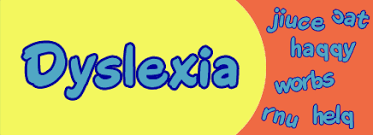
Affects reading and related language-based processing skills.
Dyslexia can affect reading fluency, decoding, reading comprehension, recall, writing, spelling, and sometimes speech and can exist along with other related disorders. Dyslexia can be considered as a Language-Based Learning Disability.
- Difficulty in reading, reads slowly.
- Experiences decoding errors.
- Shows wide disparity between listening and reading comprehension of same text.
- Has trouble with spelling.
- Exhibits difficulty recalling known words.
- May have trouble with math computations.
- Substitutes one small sight word for another: a, I, he, the, there, was.
Signs and Symptoms
- Provide a quiet area for activities like reading, answering comprehension questions.
- Encourage audio books.
- Use books with large print.
- Provide a copy of lecture notes.
- Don’t cut marks for spelling errors.
- Allow the use of a laptop or other computer for in-class essays.
- Use multi-sensory teaching methods
- Teach students to use logic rather than rote memory.
- Present material in small units.
Strategies to help
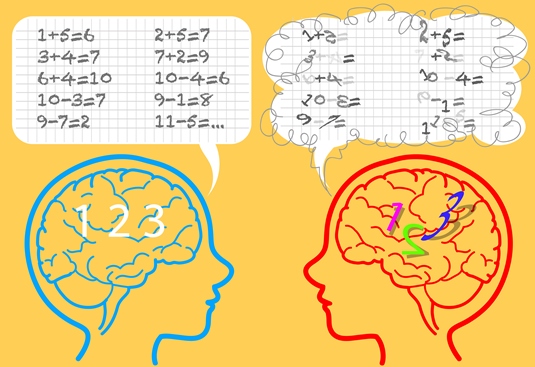
Dyscalculia affects a person’s ability to understand numbers and learn math facts.
- Shows difficulty understanding concepts of place value, and quantity, number lines, positive and negative value, carrying and borrowing.
- Has difficulty understanding and doing word problems.
- Has difficulty sequencing information.
- Exhibits difficulty using steps involved in math operations.
- Shows difficulty understanding fractions.
- Is challenged making change and handling money.
- Displays difficulty recognizing patterns when adding, subtracting, multiplying, or dividing.
- Has difficulty putting language to math processes.
- Has difficulty understanding concepts related to time such as days, weeks, months, seasons, quarters, etc.
- Exhibits difficulty organizing problems on the page, keeping numbers lined up, following through on long division problems.
Signs and Symptoms
- Allow use of fingers to count.
- Use diagrams and draw math concepts.
- Provide peer assistance.
- Suggest use of colored pencils to differentiate problems.
- Draw pictures of word problems.
- Use rhythm and music to teach math facts.
Strategies to help
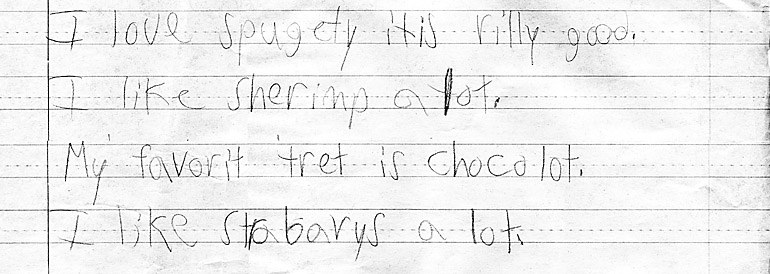
Dysgraphia affects a person’s ability to write and fine motor skills.
He may have illegible handwriting, inconsistent spacing, poor spatial planning, poor spelling, and difficulty composing writing.
- Shows inconsistent writing.
- Inconsistent spacing between words and letters.
- Illegible printing and cursive writing.
- Has unfinished words or omitted words.
- Exhibits strange wrist, body or paper position.
- Has difficulty pre-visualizing letter formation,
- Copying or writing is slow or labored.
Signs and Symptoms
- Use oral exams.
- Allow the use of a note taker.
- Provide notes or outlines to reduce the amount of writing required.
- Suggest use of computer.
- Avoid blaming student for sloppy, careless work.
- Provide alternatives to written assignments.
Strategies to help
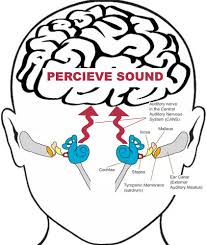
Individuals with Auditory Processing Disorder (APD) find it difficult to recognize subtle differences between sounds in words, even when the sounds are loud and clear enough to be heard.
- He may misspell and mispronounces similar-sounding words.
- He may have difficulty explaining thought.
- He may have difficulty in processing and remembering language-related task.
- He may find it difficult to stay focused on or remember a verbal presentation.
- He may have difficulty following directions in a series.
- Says “What?” a lot, even when has heard much of what was said.
Signs and Symptoms
- Help to understand confusing oral and/or written directions.
- Ask specific questions as you teach to find out if they do understand.
- Show rather than explain.
- Supplement with visual cues, signals, handouts, manipulatives.
- Allow them 5-6 seconds to respond (“think time”).
- Have the student constantly verbalize concepts, vocabulary words, rules, etc.
How can parent help?
Non-Verbal Learning Disability (NVD or NVLD), is a disorder which is usually characterized by a significant discrepancy between higher verbal skills and weaker motor, visual-spatial and social skills.
- Clumsy- seems to be constantly “getting in the way,”.
- Has trouble recognizing nonverbal cues.
- May have poor psycho-motor coordination.
- May find tying shoes, writing, using scissors a challenge.
- Has difficulty coping with changes in routing and transitions.
- Has difficulty generalizing previously learned information.
- Has difficulty following multi-step instructions.
Signs and Symptoms
- Simplify and break down abstract concepts.
- Prepare the child in advance for changes.
- Give several verbal cues before transition.
- Help to generalize instructions or concepts.
- Implement a modified schedule.
- Offer added verbal explanations when the child seems lost.
Strategies
ADHD – A disorder that includes difficulty staying focused and paying attention, controlling behavior and hyperactivity. Affects, planning, organization, strategizing, attention to details and managing time and space.
Dyspraxia – A disorder which causes problems with movement and coordination, language and speech & executive Functioning.
Memory – Affects storing and later retrieving information or getting information out.
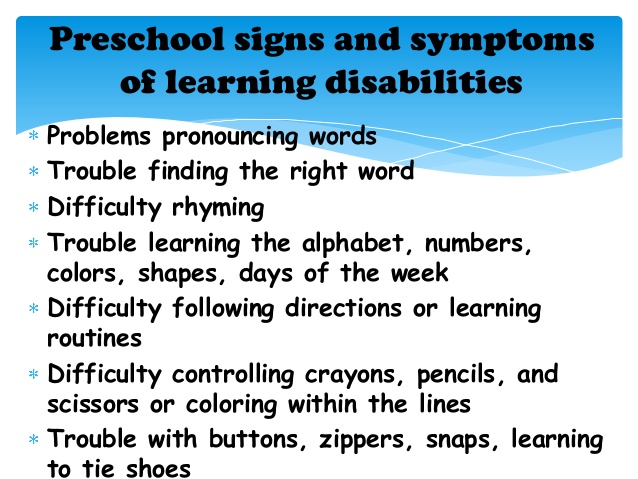
Signs you may see-
- Difficulty finding the right word.
- Difficulty in remembering rhymes.
- Trouble learning numbers, alphabet, days of the week, colors and shapes.
- Difficulty following directions or learning routines.
- Difficulty controlling pencil, crayons, scissors.
- Difficulty with buttoning, zipping, typing skills?
Pre-School
- Have trouble learning the connection between letters and sounds.
- Confuse basic words.
- Make consistent reading and spelling errors.
- Have trouble learning basic math concepts.
- Have trouble learning about sequence.
- Have trouble remembering facts.
Primary School
- Difficulty with reading comprehension or math skills.
- With prefixes, suffixes, root words and other spelling.
- Organizing his/her bedroom, notebook, papers, and desk.
- Keeping up with papers or assignments.
- Difficulty with handwriting.
- Difficulty with time management.
- Difficulty with understanding oral discussions and expressing thoughts aloud.
Middle School
- Spelling the same word differently in a single document.
- Difficulty in reading or writing tasks.
- Difficulty with open-ended questions.
- Difficulty with memory skills.
- Difficulty in adapting skills from one setting to another.
- Slow work pace.
- Difficulty in grasping abstract concepts.
- Misreading information.
High School and Adults
Parental Attitude- What can help?
- Acknowledge that your child who is having difficulty in school, could have a potential learning disability.
- Understand that these children are as or more intelligent as their peers. Only that their brains are wired differently for learning.
- Do not label them as slow or lazy.
- Get the diagnosis early.
- Start early remediation. If they receive appropriate help by the first grade, 90% of them will achieve normal reading ability.
- Do not focus on the disability alone, do the needed steps
- Enjoy your child & focus on his strengths.
- Do not be over anxious and you may transfer the anxiety to the child.
Steps for making diagnosis of LD in Mumbai, India
- Write down the difficulties child is facing in academics.
- Discuss with class teacher and get summary as well.
- See your pediatrician.
- Get you child tested from any dyslexia center.
- The following tests are performed –
- WISC/ MISIC for IQ evaluation
- DTLD/ WRAT/Woodcock Johnson’s test battery -For academic skills
- ADHDt for attention issues
- Hearing & Ophthalmic tests to rule out other disability.
Diagnosis can be done in any center, but certification happens in any of the 3 Municipal Hospitals (Sion/Nair/KEMH) and needs a formal letter from school explaining the child’s difficulties on a school letterhead.
